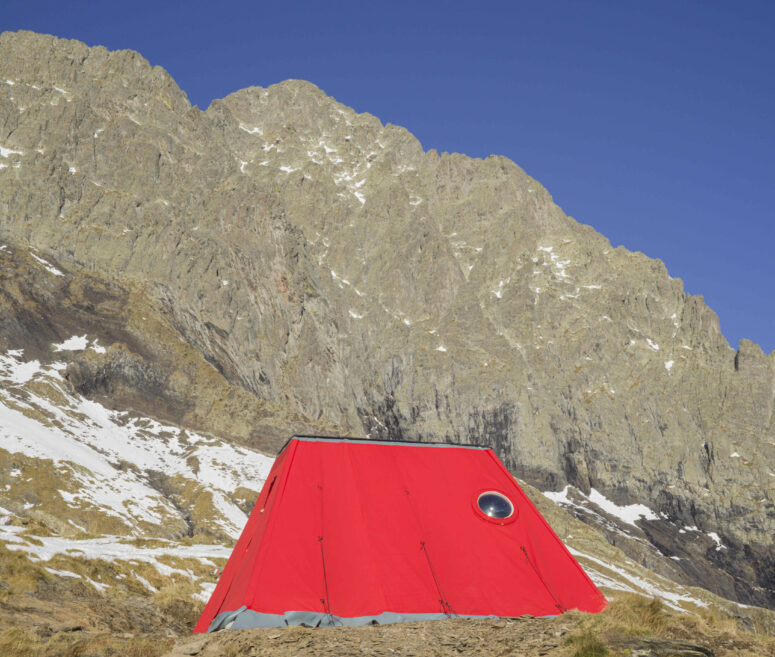The new Aldo Frattini Bivouac is a special project born from the collaboration between GAMeC – Galleria d’Arte Moderna e Contemporanea di Bergamo and the Bergamo section of the Italian Alpine Club, as part of Thinking Like a Mountain – The Orobie Biennial, the program which, under the artistic direction of Lorenzo Giusti, explores the relationship between art, territories, and both human and “more-than-human” communities.
It was developed by EX., a research and design studio which brings together art, landscape, and sustainable technology through architecture.
Located at around 2,300 meters above sea level along the Alta Via delle Orobie Bergamasche in Val Seriana, the bivouac sits in a landscape defined by jagged peaks, rocky slopes, alpine pastures, and snowfields. A particularly evocative area due to its pristine nature and the variety of flora and fauna typical of mountain environments — and a place of passage for many hikers and climbers.
The new structure, realized with the support of Fondazione Cariplo and Fondazione della Comunità Bergamasca, is conceived as a high-altitude “base” for GAMeC: a cultural presence in the mountains, a permanent shelter and resting point that, while not hosting exhibitions or events, offers a unique aesthetic experience in dialogue with the alpine landscape.
The new structure designed by EX. is envisioned as a lightweight, reversible, and technologically advanced shelter. Its form recalls the shape of a classic alpine tent, evoking the spirit of early high-mountain exploration, and aims to minimize environmental impact. Created in collaboration with Ferrino — a historic Italian company with expertise in outdoor equipment — the structure is covered with an innovative textile “skin”, designed for resistance to atmospheric agents.
The new bivouac represents the first permanent emergency textile structures in an alpine environment: an experimental prototype combining sustainability, rapid assembly, and spatial efficiency. The construction system, developed specifically for this project, allows installation in extreme contexts thanks to a total weight of just 2,500 kg and a minimal footprint of approximately 2.5 square meters.
Its compact size (3.75 x 2.60 x 2.60 m) and tapered shape reflect a design approach focused on functionality and low environmental impact. The interior is lined with natural cork, providing both thermal and acoustic insulation and creating a warm, immersive atmosphere.
Designed to accommodate up to nine people, the bivouac features perimeter benches and foldable beds inspired by alpine portaledges, which can also be converted into emergency stretchers. A solution that highlights the dual nature of the structure: both a refuge and a survival tool — a human station in an extreme environment.
The interior space, lit from above, offers a rich sensory experience: the scent of cork, the muffled silence, and the light filtering in from a skylight and two panoramic portholes create a suspended, almost meditative atmosphere.
The design is inspired by Shelter (1973) by Lloyd Kahn and Bob Easton — a book celebrating lightweight, self-built, and temporary dwellings. Like the fragile huts and tents depicted in those pages, the new Frattini Bivouac embraces impermanence and adaptability as essential qualities. At the same time, the project draws on the theory of “shearing layers,” developed by Stewart Brand and Frank Duffy, which views architecture as a system of continuously evolving parts.
From this perspective, the bivouac is not a finished object, but a living, reversible structure, able to adapt to the extreme and ever-changing conditions of the mountain.
The new Frattini Bivouac will also function as a scientific outpost. Equipped with environmental sensors, it will collect real-time data on the surrounding alpine ecosystem. This integration transforms the bivouac into an active tool for environmental monitoring and protection, extending the concept of fragility into a gesture of care and observation. The data collected will be transmitted to GAMeC headquarters, creating an ongoing flow of information between the mountain environment and the city.
With the new Frattini Bivouac, GAMeC strengthens its commitment to sustainability — a path that has been central to the Thinking Like a Mountain project. Far from traditional exhibition spaces, this intervention proposes a new way of inhabiting high altitudes: not to dominate, but to listen; not to build forever, but to design what is possible. A gesture that is both an architectural challenge and a cultural reflection — one that opens new horizons on the role of architecture and contemporary creativity in remote landscapes.
The engineering of the construction system, the pre-assembly at the factory, and the installation at high altitude were carried out by Abitare Legno S.r.l., a company specialized in the design, prefabrication, and construction of timber buildings.
The project was made possible with the support of:
Fondazione Cariplo
Fondazione della Comunità Bergamasca
Thanks to:
Sacbo S.p.A.
Abitare Legno S.r.l.
Ferrino S.p.A.
Tecnosugheri S.r.l.
The project for the new Bivacco Frattini embraces fragility as an aesthetic, rejecting the idea of a bivouac as a smooth, immaculate object. This red textile cover is not just a protection, but a declaration of vulnerability: light, provisional, and open to change.
EX.
The new Bivacco Frattini represents the tangible legacy of the two-year project “Thinking Like a Mountain”, a program that explores the relationship between art, landscapes, and both human and more-than-human communities. Not an exhibition space, but a high-altitude outpost in constant dialogue with the Alpine landscape. An emergency shelter that preserves its original function while taking on symbolic and cultural significance. Together with the CAI, we chose to promote a responsible approach to the mountains, guided by the belief that true knowledge arises only through awareness and care. We hope this collaboration will continue in the future, giving rise to new shared paths.
Lorenzo Giusti, Director of GAMeC
The first Frattini bivouac was installed in 1970. Two years later, it was destroyed by an avalanche and, in 1975, rebuilt a short distance away in a safer location along the ridge between Pizzo del Diavolo and Pizzo Tendina. Over time, the original structure was no longer suitable, which made the replacement project promoted by GAMeC especially important.
Dario Nisoli, President of CAI Bergamo
This innovative high-altitude bivouac preserves its essential function as a shelter and emergency refuge along the Sentiero delle Orobie, overlooking the extraordinary amphitheater dominated by the Redorta, Scais, and Coca peaks. It is the result of a multidisciplinary and multicultural collaboration born from GAMeC’s creative vision, which intertwined with expertise in minimal construction and the qualified volunteer work of CAI. This synergy will strengthen responsible use of the Alta Via delle Orobie Bergamasche and help promote education and respect for our mountains.
Paolo Valoti, former President of CAI Bergamo





